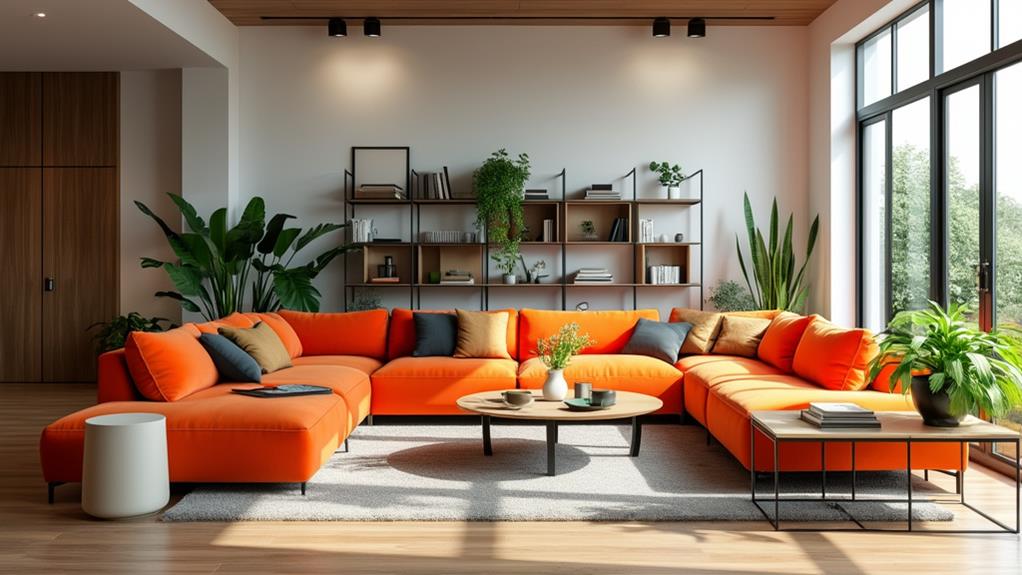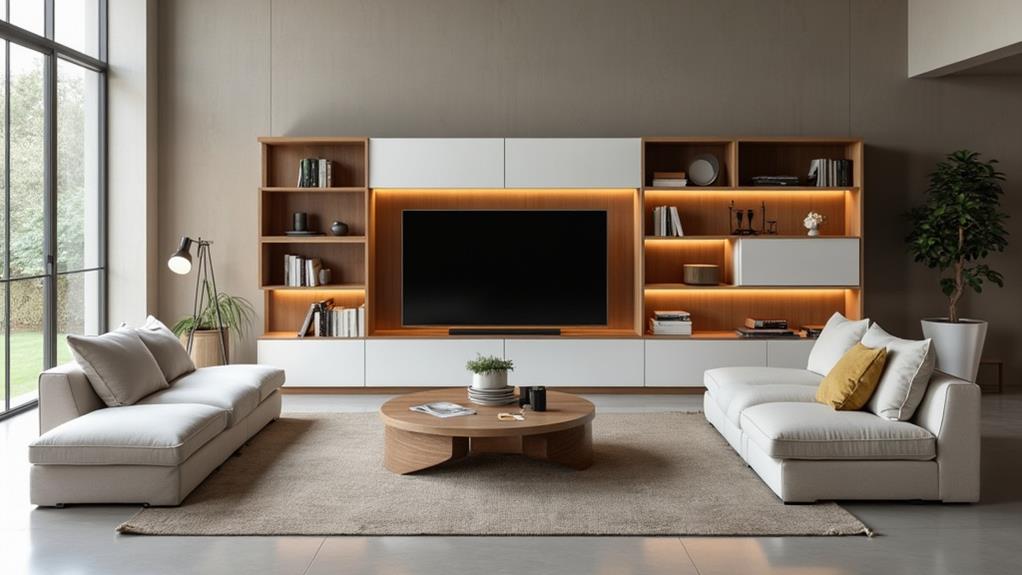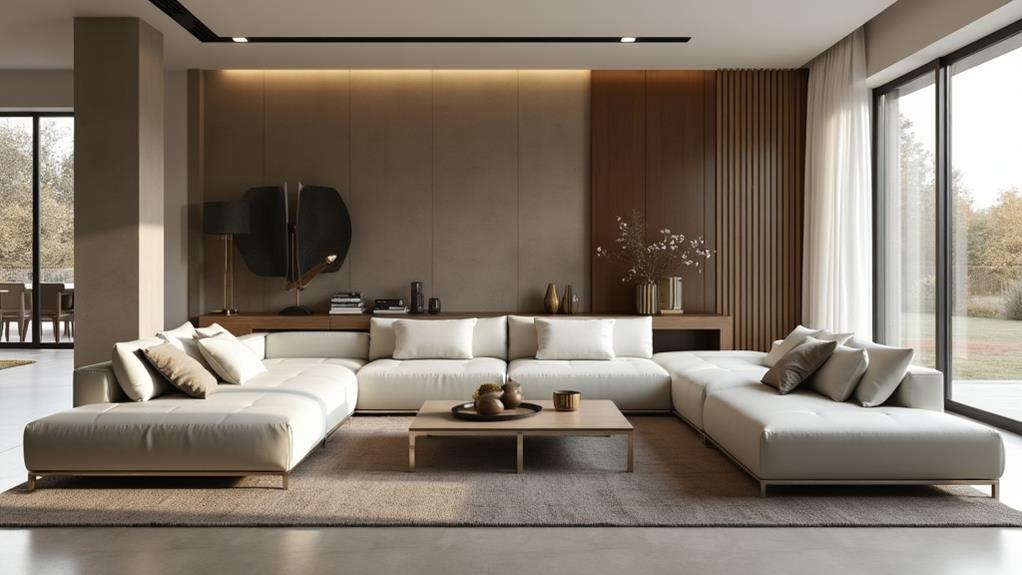Modular furniture, with its individual components that seamlessly integrate, provides unparalleled flexibility for adapting our homes to changing needs. Designed for easy assembly and disassembly, these versatile pieces optimize space and functionality, making them ideal for smaller homes or dynamic living environments. The sleek, modern design complements various interior styles, while the ability to reconfigure or expand as needed supports a clutter-free, organized living area. This approach not only enhances visual appeal but also promotes sustainability by reducing waste. By understanding the benefits and features of modular furniture, we can transform single rooms into multi-purpose, efficiently utilized spaces. Explore further to master the art of flexible living.
Understanding Modular Furniture

Let's plunge into the concept of modular furniture and explore what makes it so appealing. At its core, modular furniture consists of individual components or units that can be combined in various configurations to suit different needs and spaces. These pieces are designed to be versatile, enabling us to adapt our living environments as requirements change over time. By re-configuring the units, we can customize our furniture layouts without the need for entirely new purchases.
One of the key characteristics of modular furniture is its adaptability. The units typically feature standardized dimensions, allowing them to fit together seamlessly. This modularity extends to a wide range of furniture types, including sofas, shelving systems, and even bedroom sets. Each piece can function independently or as part of a larger, cohesive system.
The design and engineering behind modular furniture prioritize ease of assembly and disassembly, which means we can effortlessly rearrange or expand our setups.
Moreover, modular furniture often incorporates modern aesthetics and materials, resulting in a sleek, contemporary appearance that complements various interior design styles. By understanding these fundamental aspects, we can appreciate why modular furniture has become a popular choice for many households.
Benefits of Modular Furniture
One of the standout benefits of modular furniture is its unparalleled flexibility. This adaptability allows us to reconfigure our living spaces with ease, accommodating changing needs without the hassle of purchasing new pieces.
Modular furniture is designed to be versatile; individual components can be rearranged to fit different room layouts or purposes, making it an excellent choice for both small apartments and expansive homes.
Moreover, modular furniture often features a sleek, modern design that complements a wide range of interior styles. Its components are typically lightweight and easy to move, which means we can effortlessly shift pieces around to create new arrangements.
This is particularly advantageous for those of us who frequently entertain guests or simply enjoy revitalizing our home's look.
Additionally, modular furniture tends to be more sustainable than traditional options. Because we can modify and expand it over time, there's less need to discard old items and buy new ones.
This not only reduces waste but also makes for a more cost-effective long-term investment. By choosing modular furniture, we can enjoy a dynamic, stylish, and eco-friendly living environment that evolves with our lifestyle.
How Modular Furniture Enhances Flexibility

With the benefits of modular furniture clearly established, it's important to explore how exactly this type of furniture enhances flexibility in our living spaces. Modular furniture allows us to reconfigure our environment with ease, adapting to changing needs and preferences without significant effort or expense. This adaptability means we can transform a living room into a guest bedroom or a workspace simply by rearranging components.
Additionally, ergonomic seating options guarantee that even home office setups remain comfortable and functional.
One major advantage of modular furniture is its capacity for customization. We can select and combine different modules to create furniture that fits perfectly within our unique space constraints and aesthetic preferences. This level of personalization guarantees that our homes remain functional and visually appealing, no matter how our needs evolve.
Moreover, modular furniture is often designed to be lightweight and easy to move, making it simple to experiment with different layouts. This facilitates a dynamic living space that can grow and change alongside us.
Additionally, many modular pieces are designed with multifunctionality in mind, such as sofas that convert into beds or tables that expand for more seating. These features maximize utility without sacrificing style or comfort, guaranteeing that our homes remain versatile and efficient.
Choosing the Right Modular Furniture
When it comes to choosing the right modular furniture, understanding our specific needs and preferences is essential. Modular furniture offers a variety of configurations, so we must first assess the primary functions of each space. Are we looking for a sofa that transforms into a bed, or perhaps a shelving unit that doubles as a room divider? Identifying these requirements helps narrow down our choices.
We should also consider the additional storage solutions that modular furniture can provide, similar to the stylish sideboards available for dining rooms.
Next, we should consider the materials and durability of the modular pieces. High-quality materials such as hardwood, metal, or reinforced plastics guarantee longevity and resistance to wear and tear. Additionally, selecting furniture with easy-to-clean surfaces makes maintenance simpler, particularly in high-traffic areas or homes with children and pets.
Aesthetics also play an essential role in our decision-making process. We need to confirm the modular furniture we choose complements the existing décor and style of our home. Whether we prefer a minimalist, modern look or a more traditional aesthetic, there are modular options available that can seamlessly integrate into our living spaces.
Space Optimization With Modular Furniture

Maximizing our living space is a top priority, especially in smaller homes or apartments, and modular furniture is a game-changer in this regard. By utilizing modular pieces, we can tailor our furnishings to fit the unique dimensions and needs of our spaces. This adaptability is essential when dealing with limited square footage, as it allows us to make the most of every inch.
For example, storage benches provide both seating and organization, optimizing space in narrow hallways. Modular furniture often incorporates multifunctional elements, such as storage compartments within seating or beds that fold away when not in use. These features enable us to declutter our environments and maintain a clean, organized living area. Additionally, modular units can be rearranged or expanded as our needs change, providing long-term flexibility without the need for constant replacements.
Furthermore, modular furniture is typically designed with a focus on efficiency and practicality. For instance, shelving units can be stacked vertically, maximizing wall space and freeing up floor area. In compact kitchens, modular islands or countertops can be moved or extended to create additional workspace only when necessary.
Versatility of Modular Furniture
Adapting our living spaces to be both functional and stylish becomes even more exciting when we consider the versatility of modular furniture. This adaptability allows us to customize our furniture arrangements to meet our evolving needs without compromising on aesthetics or practicality.
For instance, solid wood accent furniture can be an excellent addition to modular settings, offering durability and timeless charm. Modular pieces can be reconfigured, expanded, or minimized, making them ideal for any room size or shape.
We can take advantage of modular furniture's inherent flexibility to create personalized solutions. For instance, a modular sofa can be rearranged into a sectional for entertaining guests or split into individual chairs for a more intimate setting. This adaptability extends to storage units, with modular shelving that can be adjusted in height or width, accommodating our growing collections of books, decor, or electronics.
Moreover, modular furniture often features a modern, streamlined design that seamlessly integrates with various interior styles. Whether our decor leans towards minimalist, contemporary, or eclectic, modular pieces can blend in harmoniously, adding both functionality and visual appeal.
Creating Multi-Purpose Spaces

Creating multi-purpose spaces in our homes can drastically enhance both the functionality and aesthetic appeal of our living areas. By integrating modular furniture into our design, we can transform a single room into a versatile environment that serves multiple needs. For instance, a living room can effortlessly convert into a guest bedroom or a home office by employing modular sofas that double as beds or desks with foldable extensions. This adaptability allows us to maximize our available space without sacrificing comfort or style.
Moreover, modular furniture often includes storage solutions that help maintain a clutter-free environment. Multi-functional pieces such as ottomans with hidden compartments or shelving units that can be reconfigured based on our needs contribute to an organized and efficient home. This efficient use of space is particularly beneficial in smaller homes or apartments where every square foot counts.
Additionally, modular furniture offers the flexibility to reconfigure our living spaces as our needs change over time. Whether accommodating a growing family, adjusting to remote work requirements, or simply revitalizing our home's layout, modular pieces provide the adaptability necessary to keep our spaces relevant and functional.
Interior Design With Modular Pieces
Incorporating modular pieces into our interior design not only enhances functionality but also allows for a unique and personalized aesthetic. Modular furniture provides us with the flexibility to adapt spaces according to our needs, which is particularly valuable in homes with limited square footage.
By selecting pieces that can be rearranged, expanded, or reduced, we can create a dynamic living environment that evolves with our lifestyle changes.
For example, modular sofas can be reconfigured into different seating arrangements, making them perfect for both intimate gatherings and larger social events. Shelving units with adjustable components can serve as room dividers, storage solutions, or display areas, depending on our requirements.
Additionally, modular desks and tables offer the ability to adjust height and dimensions, catering to various tasks and preferences.
The aesthetic appeal of modular furniture lies in its versatility and clean lines. Many modular designs feature minimalist styles that blend seamlessly with a range of interior themes, from contemporary to industrial.
We can also customize finishes, fabrics, and colors to reflect our personal taste. This adaptability guarantees that our living spaces remain both functional and visually appealing, regardless of shifting trends or emerging needs.
Tips for Flexible Layouts

When designing flexible layouts, it's essential to focus on mobility and multifunctionality within our spaces. By incorporating modular furniture, we can create dynamic environments that adapt to our changing needs.
Start by selecting pieces that serve multiple purposes, such as sofas that convert into beds or tables with adjustable heights. This approach maximizes the utility of each item, guaranteeing we make the most of our available space.
Next, prioritize lightweight and movable furniture. Items with wheels or easy-to-grip handles enable effortless rearrangement, allowing us to transform a living room into a guest bedroom or a home office with minimal effort.
Consider modular shelving systems that can be reconfigured to accommodate different storage needs or display arrangements.
Additionally, plan our layouts with open space in mind. Avoid overcrowding rooms with too many pieces; instead, leave ample room for movement and reconfiguration. This practice not only enhances the sense of spaciousness but also guarantees that we can easily adapt the area for different uses.
Lastly, keep in mind the aesthetic coherence. While functionality is key, maintaining a consistent design theme guarantees our flexible layouts remain visually appealing, creating harmonious and adaptable living spaces.

